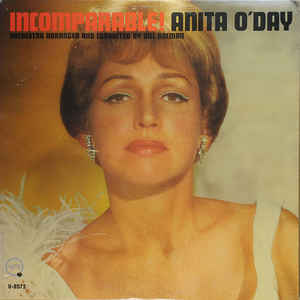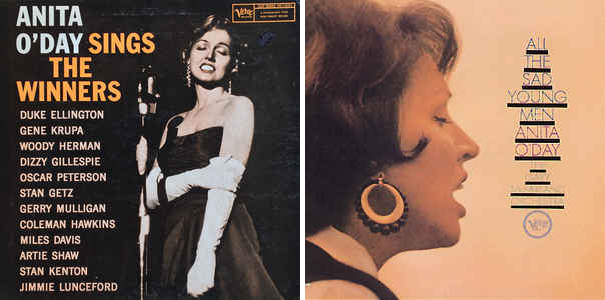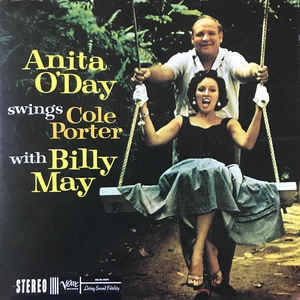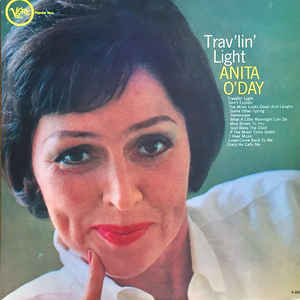Incomparable: Anita O’Day

“When she changed her name to O’Day, one of greatest exponents of the art of jazz singing came into being. Her unique sense of rhythm and dynamics quickly set her apart, and she demonstrated her great skills with the bands of Woody Herman, Stan Kenton, and Gene Krupa. After leaving Krupa in 1946, O’Day set out on a very successful solo career that continued right up until her death on November 23, 2006.”—Dean Pratt
Vinyl Tap
By Dean Pratt

“You know, everybody has their things, and that’s what I do. You know, I didn’t want to have a family. I didn’t want to sit at home. I didn’t want to be a housewife and own property, and I didn’t want to work in an office from 9:00 to 5:00, and so I was just out there looking to find something that I could, like, go along with and maybe contribute to the people in world.”—Anita O’Day, “Anita O’Day: Revisiting A Classic Voice,” NPR 2009.
Author’s Note: My friend Audrey Mannes Mosello put this (vinyl) ball in motion when she asked me to post my favorite albums—my essential listening list—on my Facebook wall over a specified period of time. Or something like that. Audrey, you know what you asked, but I doubt you expected the deluge that would follow as a result.

PENDLETON South Carolina—(Weekly Hubris)—March 2020—Anita O’Day is in my spotlight this March, so I’ll be sharing with you five of my favorite LP’s by this unique vocal stylist.
Anita Belle Colton, a Missouri-born jazz singer of the big band era, forever shattered the stereotype of the “girl singer.” While other women vocalists were decking themselves out in lavish evening gowns, O’Day’s wardrobe comprised a band jacket and pencil skirt: in the eyes of her audience, she wanted to be seen for what she was, a hip jazz musician.
When she changed her name to O’Day, one of greatest exponents of the art of jazz singing came into being. Her unique sense of rhythm and dynamics quickly set her apart, and she demonstrated her great skills with the bands of Woody Herman, Stan Kenton, and Gene Krupa. After leaving Krupa in 1946, O’Day set out on a very successful solo career that continued right up until her death on November 23, 2006. For a comprehensive insight into one of the truly remarkable women of jazz, check out her 1998 memoir, High Times, Hard Times, and the documentary film “Anita O’Day, The Life of A Jazz Singer,” directed by Robbie Cavolina and Ian McCrudden.
“Incomparable” finds Anita with the Bill Holman Orchestra, all tracks arranged by Bill: Al Porcino, Ray Triscari, Conte Candoli, Stu Williamson, Lee Katzman, on trumpets; Bob Enevoldson, Frank Rosolino, Lew McCreary, Kenny Shroyer, trombones; Joe Maini, Charlie Kennedy, Richie Kamuca, Bill Perkins, Jack Nimitz, on reeds; Lou Levy, Joe Mondragon, Al Hendrickson and Mel Lewis in the rhythm section. Pretty much the band of the century.

“Anita O’Day Sings The Winners” finds O’Day backed by two orchestras, Russ Garcia and Marty Paich. More of Los Angeles’ finest here as well! Russ has Stan Kenton’s 1958 brass section: Sam Noto, Billy Catalano, Lee Katzman, and Phil Gilbert on trumpets; Jim Amlotte, Kent Larson, Archie LaCoque, Kenny Shroyer, trombones; Benny Carter, Buddy Collette, Babe Russin, Ronnie Lang, reeds; Paul Smith, Tony Rizzi, Red Mitchell and Alvin Stoller in the rhythm section.
The Paich Orchestra included Don Fagerquist, Buddy Childers, Frank Beach, Dick Collins, and Jack Sheldon on trumpets; Bob Fitzpatrick, Dave Wells, Dick Nash, trombones; Med Flory, Herbie Mann, Bill Perkins, reeds; Jimmy Rowles, Buddy Clark and Mel Lewis in the rhythm section.
“All The Sad Young Men” has a band led and arranged by Gary McFarland on one of Anita’s very few New York recordings as she was based out of LA: Bernie Glow, Herb Pomeroy, and Doc Severinson, trumpets; Bob Brookmeyer, Willie Dennis, Billy Byers, trombones; Walt Levinsky, Phil Woods, Jerome Richardson, Zoot Sims, woodwinds; Hank Jones, George Duvivier, Barry Galbraith, Mel Lewis and Roy Haynes in the rhythm section.
The album features the usual unique and terrific arrangements by Gary and, due to a plane flight snafu, Anita had to record her vocals to the existing, pre-recorded tracks. That said, this album is a gem.

Anita made two albums with Billy May’s orchestra, “Swings Rodgers And Hart,” and the “Swings Cole Porter.” It’s the cats Billy usually had on hand: Conrad Gozzo, Manny Klein, Uan Rasey, and Frank Beach on trumpets; Si Zentner, Ed Kusby, Dick Noel, trombones; Skeets Herfurt, Wilbur Schwartz, Justin Gordon, Gene Cipriano, Chuck Gentry, reeds; Al Pellegrini, Tommy Tedesco, George Morrow and Mel Lewis in the rhythm section. A typical swinging Billy May date with one of the hippest singers around!

Finally, there is “Trav’lin’ Light,” with arrangements by Johnny Mandel and Russ Garcia. Two different instrumentations with Mandel’s larger band: Al Porcino, Ray Triscari, Jack Sheldon, John Anderson, trumpets; Dick Nash, Frank Rosolino, Lew McCreary, Stu Williamson (yes that Stu Williamson), trombones; Joe Maini, Chuck Gentry, reeds; and Russ Freeman, Buddy Clark, Al Viola, Mel Lewis and Larry Bunker in the rhythm section. Garcia has a smaller unit: Don Fagerquist, trumpet; Ben Webster, saxophone; Jimmy Rowles, Barney Kessel, Buddy Clark and Mel Lewis in the rhythm section.
What an era to be in the recording studios for these talented musicians. It had to be a thrill to walk into the room and see these cats waiting for the downbeat. At least we still get to hear them, now and forever, and for that I am eternally grateful. More essential listening to come in April.
Anita O’Day sings “Sweet Georgia Brown” and “Honeysuckle Rose” at the 1958 Newport Jazz Festival, captured in Bert Stern’s film “Jazz on a Summer’s Day.”